Computer-generated imagery
| Three-dimensional (3D) computer graphics |
|---|
 |
| Fundamentals |
| Primary uses |
|
| Related topics |
Computer-generated imagery (CGI) is a specific-technology or application of computer graphics for creating or improving images in
History
This section needs expansion. You can help by adding to it. (October 2023) |
The first feature film to use CGI as well as the composition of live-action film with CGI was Vertigo,[1] which used abstract computer graphics by John Whitney in the opening credits of the film. The first feature film to make use of CGI with live action in the storyline of the film was the 1973 film Westworld.[2] Other early films that incorporated CGI include Star Wars: Episode IV (1977),[2] Tron (1982), Star Trek II: The Wrath of Khan (1982),[2] Golgo 13: The Professional (1983),[3] The Last Starfighter (1984),[4] Young Sherlock Holmes (1985), The Abyss (1989), Terminator 2: Judgement Day (1991), Jurassic Park (1993) and Toy Story (1995). The first music video to use CGI was Dire Straits's award-winning "Money for Nothing" (1985), whose success was instrumental in giving the process mainstream exposure.[citation needed]
Prior to CGI being prevalent in film, virtual reality, personal computing and gaming, one of the early practical applications of CGI was for aviation and military training namely, the flight simulator. Visual systems developed in flight simulators were also an important precursor to three dimensional computer graphics and Computer Generated Imagery (CGI) systems today. Namely because the object of flight simulation was to reproduce on the ground the behavior of an aircraft in flight. Much of this reproduction had to do with believable visual synthesis that mimicked reality.[5] The Link Digital Image Generator (DIG) by the Singer Company (Singer-Link), was considered one of the worlds first generation CGI systems.[6] It was a real-time, 3D capable, day/dusk/night system that was used by NASA shuttles, for F-111s, Black Hawk and the B-52. Link's Digital Image Generator had architecture to provide a visual system that realistically corresponded with the view of the pilot.[7] The basic archictecture of the DIG and subsequent improvements contained a scene manager followed by geometric processor, video processor and into the display with the end goal of a visual system that processed realistic texture, shading, translucency capabilties, and free of aliasing.[8]
Combined with the need to pair virtual synthesis with military level training requirements, CGI technologies applied in flight simulation were often years ahead of what would have been available in commercial computing or even in high budget film. Early CGI systems could depict only objects consisting of planar polygons. Advances in algorithms and electronics in flight simulator visual systems and CGI in the 1970s and 1980s influenced many technologies still used in modern CGI adding the ability to superimpose texture over the surfaces as well as transition imagery from one level of detail to the next one in a smooth manner.[9]
The evolution of CGI led to the emergence of virtual cinematography in the 1990s, where the vision of the simulated camera is not constrained by the laws of physics. Availability of CGI software and increased computer speeds have allowed individual artists and small companies to produce professional-grade films, games, and fine art from their home computers.
Static images and landscapes
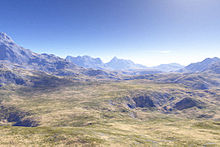
Not only do animated images form part of computer-generated imagery; natural looking landscapes (such as
Many specific techniques have been researched and developed to produce highly focused computer-generated effects — e.g., the use of specific models to represent the chemical weathering of stones to model erosion and produce an "aged appearance" for a given stone-based surface.[12]
Architectural scenes

Modern architects use services from computer graphic firms to create 3-dimensional models for both customers and builders. These computer generated models can be more accurate than traditional drawings. Architectural animation (which provides animated movies of buildings, rather than interactive images) can also be used to see the possible relationship a building will have in relation to the environment and its surrounding buildings. The processing of architectural spaces without the use of paper and pencil tools is now a widely accepted practice with a number of computer-assisted architectural design systems.[13]
Architectural modeling tools allow an architect to visualize a space and perform "walk-throughs" in an interactive manner, thus providing "interactive environments" both at the urban and building levels.[14] Specific applications in architecture not only include the specification of building structures (such as walls and windows) and walk-throughs but the effects of light and how sunlight will affect a specific design at different times of the day.[15][16]
Architectural modeling tools have now become increasingly internet-based. However, the quality of internet-based systems still lags behind sophisticated in-house modeling systems.[17]
In some applications, computer-generated images are used to "reverse engineer" historical buildings. For instance, a computer-generated reconstruction of the monastery at Georgenthal in Germany was derived from the ruins of the monastery, yet provides the viewer with a "look and feel" of what the building would have looked like in its day.[18]
Anatomical models
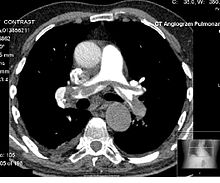
Computer generated models used in skeletal animation are not always anatomically correct. However, organizations such as the Scientific Computing and Imaging Institute have developed anatomically correct computer-based models. Computer generated anatomical models can be used both for instructional and operational purposes. To date, a large body of artist produced medical images continue to be used by medical students, such as images by Frank H. Netter, e.g. Cardiac images. However, a number of online anatomical models are becoming available.
A single patient X-ray is not a computer generated image, even if digitized. However, in applications which involve CT scans a three-dimensional model is automatically produced from many single-slice x-rays, producing "computer generated image". Applications involving magnetic resonance imaging also bring together a number of "snapshots" (in this case via magnetic pulses) to produce a composite, internal image.
In modern medical applications, patient-specific models are constructed in 'computer assisted surgery'. For instance, in total
Cloth and skin images
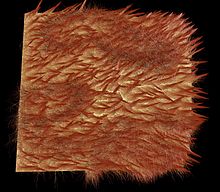
Models of cloth generally fall into three groups:
- The geometric-mechanical structure at yarn crossing
- The mechanics of continuous elastic sheets
- The geometric macroscopic features of cloth.[21]
To date, making the clothing of a digital character automatically fold in a natural way remains a challenge for many animators.[22]
In addition to their use in film, advertising and other modes of public display, computer generated images of clothing are now routinely used by top fashion design firms.[23]
The challenge in rendering human skin images involves three levels of realism:
- Photo realism in resembling real skin at the static level
- Physical realism in resembling its movements
- Function realism in resembling its response to actions.[24]
The finest visible features such as fine wrinkles and skin pores are the size of about 100 μm or 0.1 millimetres. Skin can be modeled as a 7-dimensional bidirectional texture function (BTF) or a collection of bidirectional scattering distribution function (BSDF) over the target's surfaces.
Interactive simulation and visualization
Interactive visualization is the rendering of data that may vary dynamically and allowing a user to view the data from multiple perspectives. The applications areas may vary significantly, ranging from the visualization of the flow patterns in
At the abstract level, an interactive visualization process involves a "data pipeline" in which the raw data is managed and filtered to a form that makes it suitable for rendering. This is often called the "visualization data". The visualization data is then mapped to a "visualization representation" that can be fed to a rendering system. This is usually called a "renderable representation". This representation is then rendered as a displayable image.[26] As the user interacts with the system (e.g. by using joystick controls to change their position within the virtual world) the raw data is fed through the pipeline to create a new rendered image, often making real-time computational efficiency a key consideration in such applications.[26][27]
Computer animation
While computer-generated images of landscapes may be static, computer animation only applies to dynamic images that resemble a movie. However, in general, the term computer animation refers to dynamic images that do not allow user interaction, and the term virtual world is used for the interactive animated environments.
Computer animation is essentially a digital successor to the art of
To create the illusion of movement, an image is displayed on the
Text-to-image models
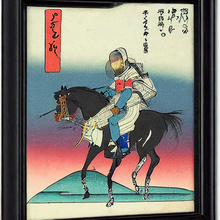
A
Text-to-image models began to be developed in the mid-2010s during the beginnings of the
Virtual worlds
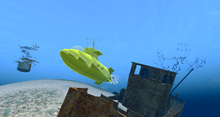
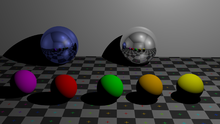
A virtual world is an agent-based and simulated environment allowing users to interact with artificially animated characters (e.g software agent) or with other physical users, through the use of avatars. Virtual worlds are intended for its users to inhabit and interact, and the term today has become largely synonymous with interactive 3D virtual environments, where the users take the form of avatars visible to others graphically.[29] These avatars are usually depicted as textual, two-dimensional, or three-dimensional graphical representations, although other forms are possible[30] (auditory[31] and touch sensations for example). Some, but not all, virtual worlds allow for multiple users.
In courtrooms
Computer-generated imagery has been used in courtrooms, primarily since the early 2000s. However, some experts have argued that it is prejudicial. They are used to help judges or the jury to better visualize the sequence of events, evidence or hypothesis.[32] However, a 1997 study showed that people are poor intuitive physicists and easily influenced by computer generated images.[33] Thus it is important that jurors and other legal decision-makers be made aware that such exhibits are merely a representation of one potential sequence of events.
Broadcast and live events
Weather visualizations were the first application of CGI in television. One of the first companies to offer computer systems for generating weather graphics was ColorGraphics Weather Systems in 1979 with the "LiveLine", based around an Apple II computer, with later models from ColorGraphics using Cromemco computers fitted with their Dazzler video graphics card.
It has now become common in weather casting to display full motion video of images captured in real-time from multiple cameras and other imaging devices. Coupled with 3D graphics symbols and mapped to a common virtual geospatial model, these animated visualizations constitute the first true application of CGI to TV.
CGI has become common in sports telecasting. Sports and entertainment venues are provided with see-through and overlay content through tracked camera feeds for enhanced viewing by the audience. Examples include the yellow "
Motion-capture
Computer-generated imagery is often used in conjunction with
The lack of anatomically correct digital models contributes to the necessity of motion-capture as it is used with computer-generated imagery. Because computer-generated imagery reflects only the outside, or skin, of the object being rendered, it fails to capture the infinitesimally small interactions between interlocking muscle groups used in fine motor-control, like speaking. The constant motion of the face as it makes sounds with shaped lips and tongue movement, along with the facial expressions that go along with speaking are difficult to replicate by hand.[38] Motion capture can catch the underlying movement of facial muscles and better replicate the visual that goes along with the audio, like Josh Brolin's Thanos.
See also
- 3D modeling
- Cinema Research Corporation
- Cel shading
- Anime Studio
- Animation database
- List of computer-animated films
- Digital image
- Parallel rendering
- Photoshopis the industry standard commercial digital photo editing tool.
- FOSSdigital photo editing application.
- Poser DIY CGI optimized for soft models
- Ray tracing (graphics)
- Real-time computer graphics
- Shader
- Virtual human
- Virtual studio
- Virtual Physiological Human
References
Citations
- ^ Ozturk, Selen (March 15, 2023). "Vicious Circle: John Whitney and the Military Origins of Early CGI". Bright Lights Film Journal. Retrieved May 11, 2023.
- ^ Insider.com.
- ^ Halverson, Dave (December 2005). "Anime Reviews: The Professional Golgo 13". Play. No. 48. United States of America. p. 92.
- ^ "Last Starfighter sequel is super close to happening, says Gary Whitta". Archived from the original on 2021-08-29. Retrieved 2021-08-29.
- ISBN 978-0521357517.)
{{cite book}}: CS1 maint: multiple names: authors list (link - ^ Carlson, Wayne (20 June 2017). "Computer Graphics and Animation: A Retrospective Overview". Ohio State University. p. 13.2.
- ^ Suminski, Leonard and, Hulin, Paul (September 26, 1980). "Computer Generated Imagery Current Technology". U.S. Army Project Manager for Training Devices: 14–18.
{{cite journal}}: CS1 maint: multiple names: authors list (link) - ^ Yan, Johnson K. and, Florence, Judit K. "MODULAR DIGITAL IMAGE GENERATOR". United States Patent Office.
{{cite web}}: CS1 maint: multiple names: authors list (link) - S2CID 15309937.
- ^ a b c Peitgen 2004, pp. 462–466.
- ISBN 1-58450-054-9 page 240 [1]
- ISBN 0-12-221181-2page 217
- ^ Sondermann 2008, pp. 8–15.
- ISBN 3-211-79169-8, pp. 24–29.
- ^ "Light: The art of exposure". GarageFarm. 2020-11-12. Retrieved 2020-11-12.
- ISBN 1-4020-8740-3pages 136-139
- ISBN 1-59140-561-0page 1027
- ISBN 3-540-89424-1pages 114-118
- ISBN 3-540-20242-0pages 241-245
- ISBN 3-642-15704-1pages 526-560
- ISBN 1-56881-090-3page 20
- ISBN 0-237-52626-3page 21
- ISBN 0-7658-0398-4page 213
- ISBN 0-470-02316-3pages 353-370
- ISBN 0-12-715951-7page 177
- ^ ISBN 3-540-33262-6pages 1-8
- ISBN 1-84800-268-8pages 1-7
- ^ Vincent, James (May 24, 2022). "All these images were generated by Google's latest text-to-image AI". The Verge. Vox Media. Retrieved May 28, 2022.
- ^ Cook, A.D. (2009). A case study of the manifestations and significance of social presence in a multi-user virtual environment. MEd Thesis. Available online
- ^ Biocca & Levy 1995, pp. 40–44.
- ^ Begault 1994, p. 212.
- ^ Computer-generated images influence trial results The Conversation, 31 October 2013
- ^ Archived at Ghostarchive and the Wayback Machine: Arti AR highlights at SRX -- the first sports augmented reality live from a moving car!, retrieved 2021-07-14
- Azuma, Ronald; Balliot, Yohan; Behringer, Reinhold; Feiner, Steven; Julier, Simon; MacIntyre, Blair. Recent Advances in Augmented RealityComputers & Graphics, November 2001.
- ^ Marlow, Chris. Hey, hockey puck! NHL PrePlay adds a second-screen experience to live games, digitalmediawire 27 April 2012.
- PMID 30519654.
- ^ Pelachaud, Catherine; Steedman, Mark; Badler, Norman (1991-06-01). "Linguistic Issues in Facial Animation". Center for Human Modeling and Simulation (69).
Sources
- Begault, Durand R. (1994). 3-D Sound for Virtual Reality and Multimedia. AP Professional. ISBN 978-0-1208-4735-8.
- Biocca, Frank; Levy, Mark R. (1995). Communication in the Age of Virtual Reality. Lawrence Erlbaum Associates. ISBN 978-0-8058-1549-8.
- Peitgen, Heinz-Otto; Jürgens, Hartmut; Saupe, Dietmar (2004). Chaos and Fractals: New Frontiers of Science. Springer Science & Business Media. ISBN 978-0-387-20229-7.
- Sondermann, Horst (2008). Light Shadow Space: Architectural Rendering with Cinema 4D. Vienna: Springer. ISBN 978-3-211-48761-7.
External links
- A Critical History of Computer Graphics and Animation – a course page at Ohio State University that includes all the course materials and extensive supplementary materials (videos, articles, links).
- CG101: A Computer Graphics Industry Reference ISBN 073570046XUnique and personal histories of early computer graphics production, plus a comprehensive foundation of the industry for all reading levels.
- F/X Gods, by Anne Thompson, Wired, February 2005.
- "History Gets A Computer Graphics Make-Over" Tayfun King, Click, BBC World News (2004-11-19)
- NIH Visible Human Gallery
